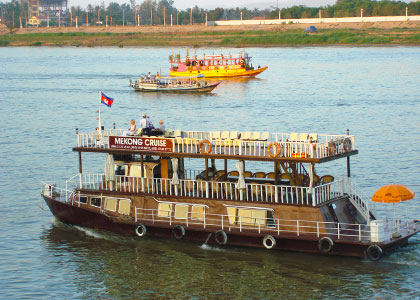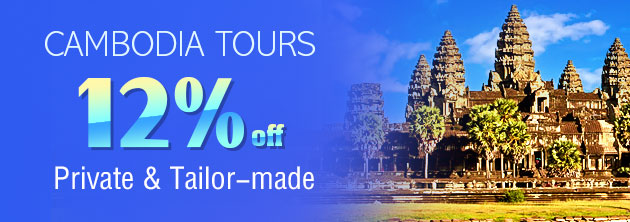Cambodia Travel Guide

|
Basic Facts of Cambodia
Location: in Indochina Peninsula, bordering Thailand on the west and the northwest, Laos on the northeast, and Vietnam on the east and the southeast, and facing Gulf Of Thailand (Gulf Of Siam) on the South.
Area: 181,305 sq km (70,002 sq mi)
Population: 15.6 million by 2015
Language: Khmer or Cambodia
Currency: Cambodian Riel, KHR for short
Time Zone: UTC+7
Capital: Phnom Penh
Administrative Division: 20 provinces and 4 municipalities directly under the central government
Religions and Beliefs: with around 95% of the population believing in Buddhism
Read More: 10 Interesting Facts about Cambodia
Top 10 Things to Do in Cambodia
Cambodia is a traditional agricultural country, and the proportion of poor people reaches 28% of the whole population. In order to grow economy and reduce poverty, the government implements opening policy. Since 2000, foreign air lines directly to Phnom Penh and Angkor tourist sites have been sustained. In 2002, investment to tourist industry has been strengthened to restore historical sites, develop new scenic spots, and improve tourist environment.
Till now, there are 3 main tourist cities:
1. Phnom Penh: to have a better understanding of the glorious and long history of this country; with famous sites such as Independence Monument, Royal Palace, Wat Phnom, and National Museum;
2. Siem Reap: to explore the mystery of Angkor; with well-known attractions, like Angkor Thom and Angkor Wat (How to Visit Angkor Wat);
3. Sihanoukville: to relax and enjoy a great moment on the beaches like Ochheuteal Beach and Otres Beach.
Read More:
10 Most Beautiful Places to Visit in Cambodia
7 Best Trekking Destinations in Cambiodia
Apart from those mentioned above, traditional dancing, Khmer Martial Arts, Khmer wedding are all great amusements for tourists to have fun.
|
|
|
Best Time to Visit Cambodia
Influenced by tropical monsoon climate, the country is rainy from May to October, and dry from November to next April. The dry period is the best time to set out a travel to Cambodia, when it's cool and windy. But a room needs to be booked in advance in high seasons such as Christmas on Dec. 25th and New Year holiday from Apr. 14th to Apr. 16th.
Read More: Cambodia Weather Phnom Penh Weather Siem Reap Weather
Transportation
The most convenient way to get to Cambodia is by flight. There are two major international airports in Phnom Penh and Siem Reap, operating flights from China, Thailand, Singapore, Vietnam, South Korea, Laos, and Malaysia. Besides, visitors can also go there through highway. Buses are available to shuttle from Ho Chi Minh City of Vietnam and Bangkok of Thailand to Phnom Penh and Siem Reap.
Inside the country, you can take tuktuks, motorbikes, and cyclos to go around cities while flights, coaches, and boats are common ways for intercity transportation.
Read More: Cambodia Trains Travel Around Cambodia by Bus Taxis in Cambodia Cambodia Cycling
Cambodia Travel Tips
Attention needs to be paid to these main tips:
1. Buddhist is the national religion of Cambodia, so remember to be respectful to the pagodas and Buddha statues;
2. It is courtesy to give tips to drivers, guides, waiters...
3. Due to the tropic climate, it is often sunny in the noon. Therefore it is not a wise decision to go out at that moment.
4. Remember to buy a Cambodia SIM card in airports or any mobile phone stores before touring.
Read More: Tipping in Cambodia Cambodia Visa Cambodia Trip Cost 5 Traditional Festivals in Cambodia
Is It Safe to Travel to Cambodia? 10 Unique Cambodian Dishes Shopping in Cambodia Where to Stay in Cambodia
History

Tonle Sap Lake at Sunset
|
Geographical Features
The middle and south of Cambodia are plain, and the east, north and west are all surrounded by mountains and highlands, all of which are covered by forests. It has the biggest freshwater lake of the Southeast Asia, called Tonle Sap Lake, also named Lake of Phnom Penh, stretching from Siem Reap and flowing into Mekong River at Phnom Penh. This lake is like a big and verdurous jade mounted in this land, shining brightly, and it provides a solid insurance of the development and prosperity to the Cambodians, which makes it "the Lake of Life".

